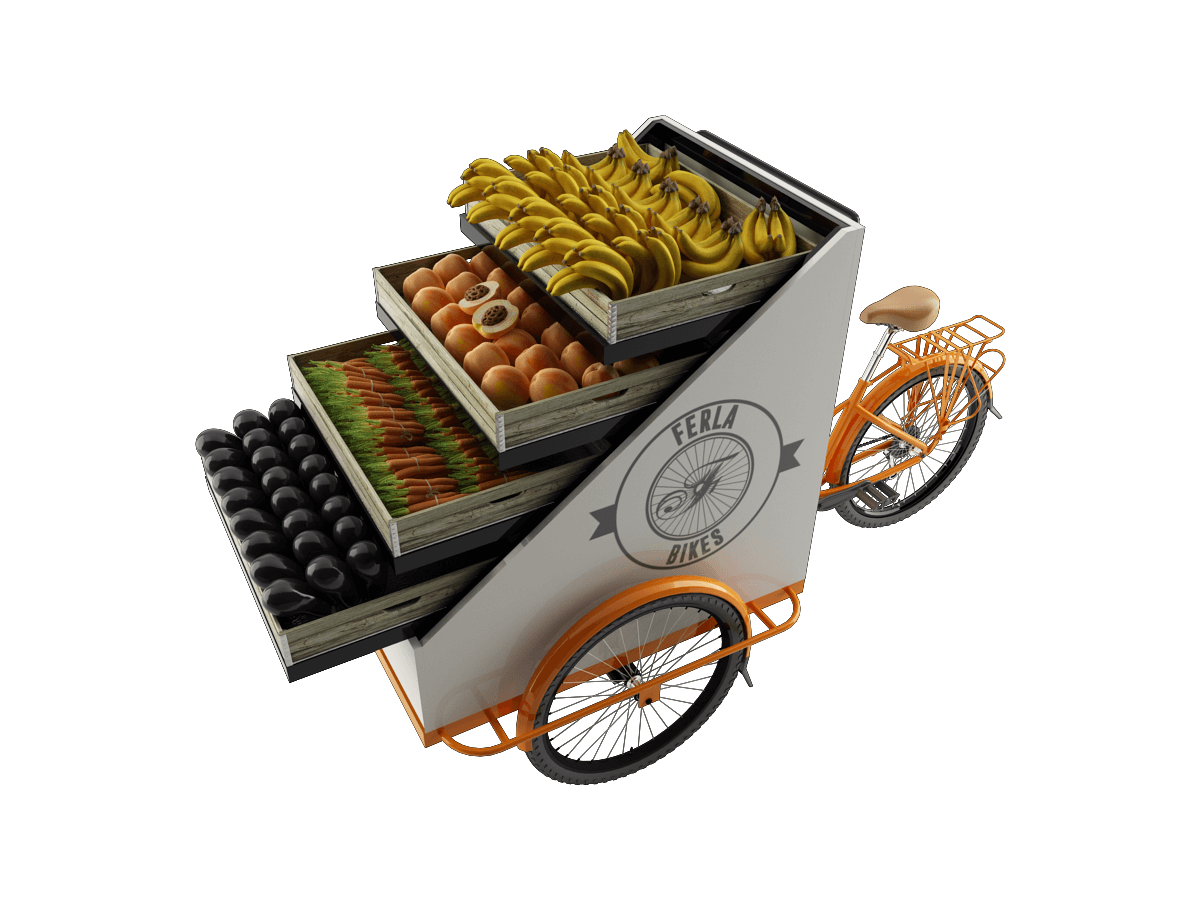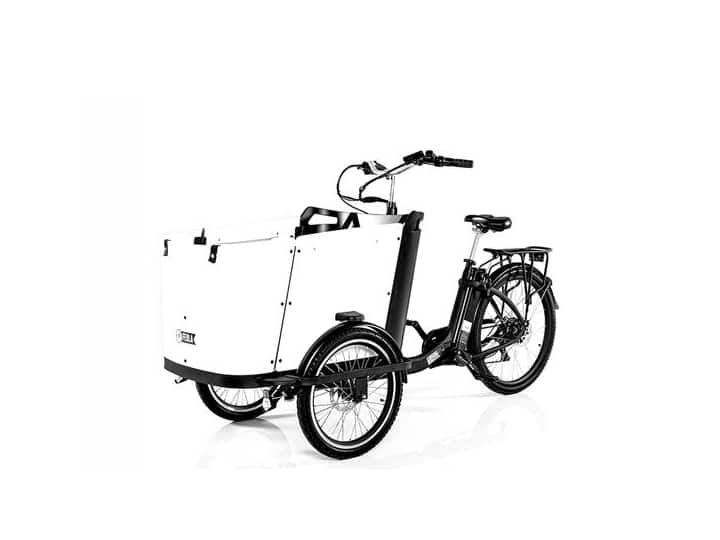Delivery Bicycles for Sale: Take Goods Transportation to a New Level with Ferla
According to studies, cargo bicycles deliver about 67% faster than vans in urban environments and can drop off nearly 10 parcels per hour, compared to 6 for vans. Both pedal-assist and electric courier bicycles also have lower operational costs than motorized vehicles and significantly reduce emissions, among other perks they provide. Just a perfect option for day-to-day delivery, isn’t it?
Ferla courier bikes for sale and rent offer independent businesses an affordable way to enter the delivery market. At the same time, big companies can harness pedal power to optimize commercial deliveries and save costs when bringing goods to people.
History and Evolution of Delivery Cycles
It often happens that the things we see as modern have deep roots. And it turns out that bikes delivery has been around for over a century in one form or another.
The first freight 3-wheelers were used by European businesses in the 1870s to haul groceries, pastries, and drugs. In the 1880s, entrepreneurs started experimenting with different ways of transporting goods on two wheels, which prompted the emergence of the renowned bakfiets bike at the turn of the century.
In the US, two-wheeled delivery bikes gained popularity during the “Great Bicycle Craze” in the 1890s due to their ability to handle heavy loads and rough urban roads, leading to the types of bicycles we now call cargo.
2- and 3-wheeled units proved their worth during the Second World War and have been widely used since the 1960s because of the oil crisis and growing sustainability pressures. At that time, cargo delivery bikes evolved greatly, revolutionizing urban traffic by cutting emissions and providing a cheaper alternative to traditional vans.
Innovation has driven further evolution of delivery trikes, so modern builds incorporate the latest tech advancements and may also be equipped with electrical assistance for hassle-free cycling.
Types of Bikes for Delivery
In the diverse world of delivery cargo bikes, you have several options for efficient goods transportation, including:
- Traditional bicycles: simple two-wheelers used for transporting lighter loads.
- Electric bicycles (e-bikes): pedal bicycles equipped with an electric motor to give a bike courier extra power.
- Cargo bicycles are larger tricycles or bikes designed for heavier loads traditionally used in food delivery and logistics.
- Specialized delivery bicycles: a specific category of bikes catering to niche purposes (refrigerated food delivery bicycles, vehicles with secure locking mechanisms, etc.).
Key Features of Delivery Bikes
Each Ferla delivery bike for sale is adapted to different courier needs, and here’s what you can expect by embracing the pedal power:
- Load capacity: despite being one of the lightest cargo trikes around, each Ferla delivery bicycle for sale can carry up to 450 lbs of payload. It’s a strong choice for various transportation needs, from small packages to more significant freight.
- Durability and design: Ferla frames are made from durable materials to meet the demands of last-mile logistics. All cargo bikes also feature puncture-resistant tires, hydraulic brakes, active frame steering, and ergonomic saddles for extra comfort during long rides.
- Technology integration: with the GPS technology integration, businesses can plan routes more efficiently, minimize delivery times, and increase customer satisfaction. Mobile apps, communication tools, and advanced tracking software may improve bicycle delivery, too.
- Speed and efficiency: a powerful Samsung battery provides rider assistance of up to 20 mph. Therefore, you can haul large loads quickly and easily, saving you from physical exhaustion at the end of the working shift. Speed characteristics are especially important if you are seeking food delivery bikes for sale since some goodies should remain hot or frozen while riding.
- Bike accessories: boost the capabilities of your Ferla courier bicycle with a lockable storage compartment or additional battery. You can also get a fully enclosed canopy and satin cover to protect your bike/goods from undesirable environmental impacts.
Advantages of Using a Cargo Bike for Delivery
- Environmental impact: deliveries on bikes produce 90% less carbon emissions than diesel vans and 30% less than electric vans.
- Cost-effectiveness: cargo bikes are much cheaper than motorized vehicles. Considering maintenance, insurance, and energy costs, 2- and 3-wheel delivery units also have up to 10 times lower expenses per parcel.
- Access to congested areas: a compact bicycle for delivery takes shortcuts through the streets closed to heavy trucks, bypasses traffic jams, and can ride as close to the customer’s door as possible. It’s also a good way to avoid parking issues.
- Health benefits: cycling is a great cardiovascular exercise that also builds endurance and muscular strength, helps maintain a healthy weight, and improves the mental well-being of a bike courier.
Challenges Faced by Delivery Bike Couriers
- Weather conditions: even though you can get an elegant overhang to protect parcels from rain, snow, and sun, cycling in bad weather may be difficult, affecting delivery performance.
- Cargo limitations: the limited dimensions of a cargo box reduce the carrying capacity of a tricycle for delivery. Hence, you will not manage to transport as many goods as most vans do.
- Safety concerns: electric delivery bikes may be a tempting target for thieves due to their value, so it’s important to park your bicycle securely and use a reliable lock for extra protection.
- Regulations: no license is needed to ride delivery bicycles with baskets. However, there may be certain speed limits you should know about so as not to get a fine. This is especially relevant in crowded cities.
Future of Cargo Bike Delivery
The future of bicycle delivery is promising, with many innovations and exciting developments. These are some areas of advancement we should look forward to:
- Technology: AI is expected to enhance the capabilities of a courier bike. The algorithms will optimize battery use, analyze rider behavior, and predict maintenance needs. E-bikes may even navigate autonomously, avoiding traffic and other obstacles.
- Sustainability initiatives: businesses will keep switching to electric bicycles in the coming years. We will also see increased use of solar power to charge a delivery trike. To reduce plastic waste, bikes will carry products in eco-friendly packaging.
- Integration with urban planning: broad adoption of cargo delivery bikes will steer urban planning strategies towards eco-friendliness. Cities will also have more bike lanes, traffic signals, and storage solutions to help couriers feel safer.
Case Studies
Many big companies have long integrated bikes into their daily delivery operations, which helped them achieve sustainability goals and increase revenue through faster goods transportation. The most prominent examples include:
- Amazon is introducing cargo bikes in New York, Berlin, and London for its Fresh delivery service.
- FedEx couriers riding 2- and 3-wheel delivery bike to haul small parcels in New York and London.
- Domino’s Pizza equips each electric bicycle for food delivery with a bag or cargo box to maintain meal quality on its way to customers.
Conclusion
Tricycle delivery has undeniable benefits for both businesses and their customers. Cargo bikes are eco-friendly, cost-effective, and extremely convenient for urban environments. They not only decrease operational costs due to zero fuel consumption but also enhance the company’s performance and customer satisfaction by providing more flexible and faster delivery options. Want to embrace pedal power in your business? Ferla delivery tricycle for sale is an ideal starter!

